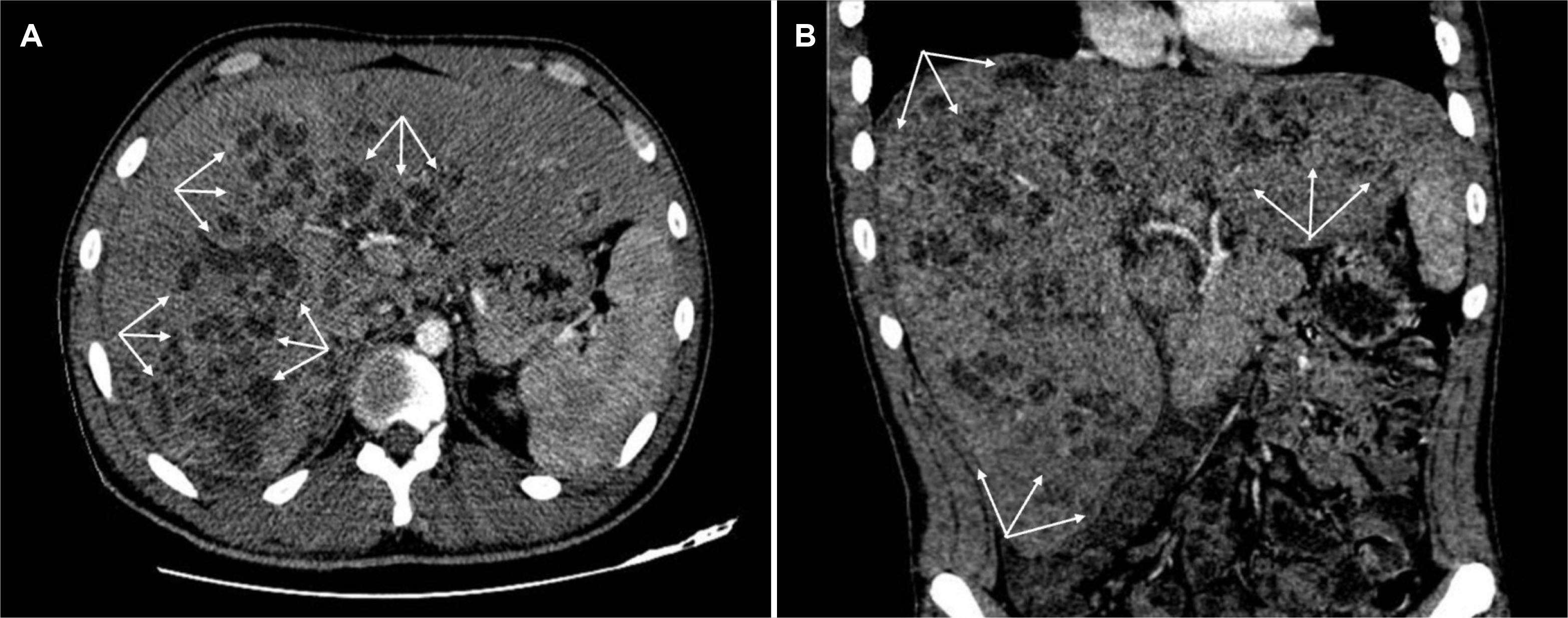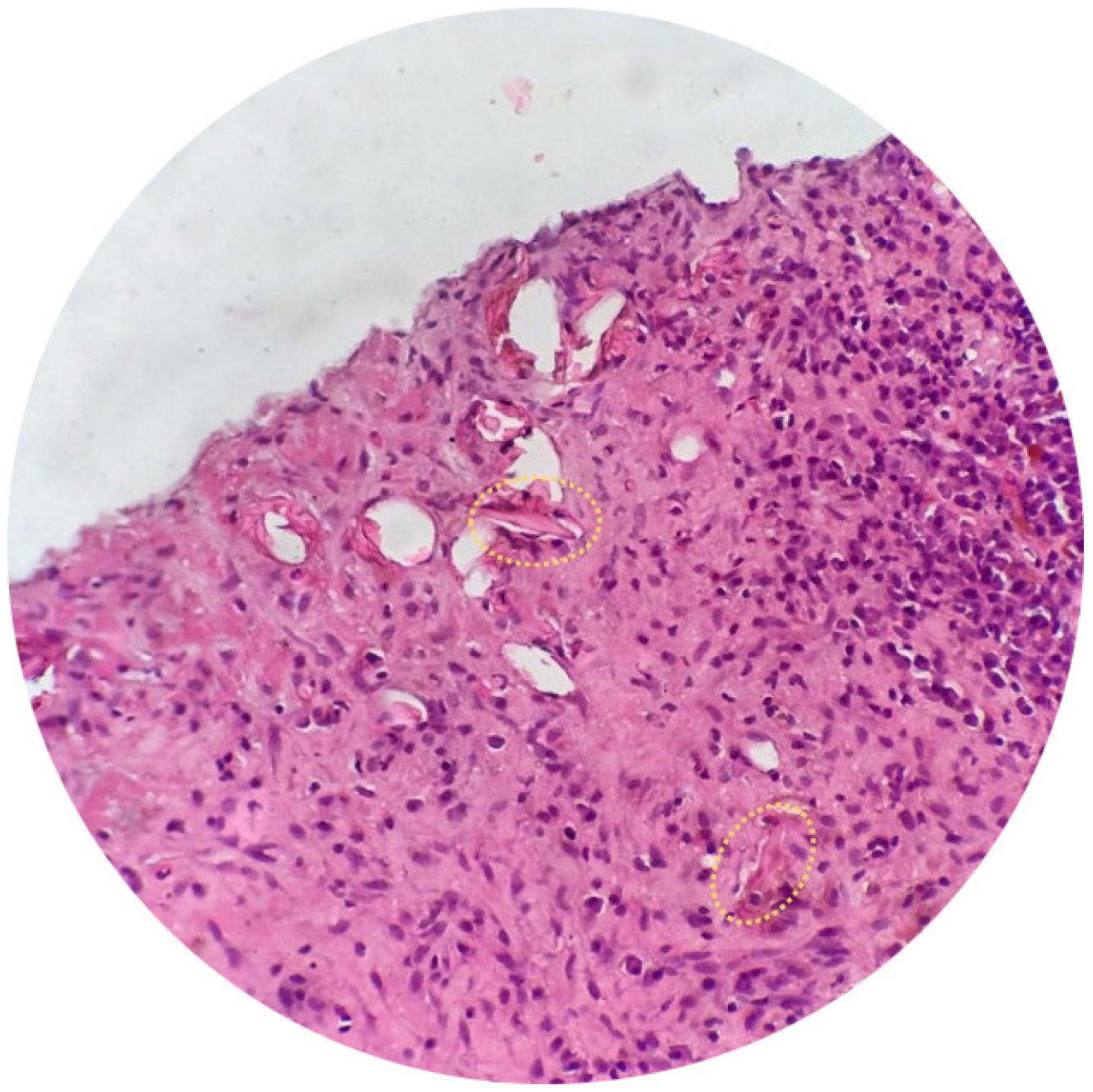Korean J Gastroenterol.
2024 Jun;83(6):247-252. 10.4166/kjg.2024.051.
Atypical Toxocara canis-Induced Hepatic Visceral Larva Migrans: Diagnostic Challenges and Literature Review
- Affiliations
-
- 1Department of Internal Medicine, University of Medicine and Pharmacy at Ho Chi Minh City, Vietnam
- 2Department of Gastroenterology, Cho Ray Hospital, Ho Chi Minh City, Vietnam
- 3Department of Pathology Cho Ray Hospital, Ho Chi Minh City, Vietnam
- 4Department of Gastroenterology, University Medical Center Ho Chi Minh City, Ho Chi Minh City, Vietnam
- KMID: 2557112
- DOI: http://doi.org/10.4166/kjg.2024.051
Abstract
- Toxocariasis, a zoonotic infection transmitted by Toxocara canis (from dogs) and Toxocara cati (from cats) larvae, poses rare but severe risks to humans. We present a case of hepatic visceral larva migrans (VLM) caused by Toxocara canis in a 21-year-old male with a history of close contact with a pet dog. Initial symptoms and imaging findings mimicked a pyogenic liver abscess. The initial laboratory investigations revealed neutrophilia and elevated levels of IgE. Despite broad-spectrum antibiotics, persistent fever prompted further investigation. Subsequent serological testing for Toxocara antibodies and histopathological analysis of liver tissue demonstrating eosinophil infiltrates and Charcot-Leyden crystals led to a confirmed diagnosis of a liver abscess caused by Toxocara canis. Serological testing for Toxocara antibodies and histopathological analysis of liver tissue confirmed a Toxocara canis-induced liver abscess. Albendazole treatment yielded significant clinical improvement. This case highlights the necessity of considering toxocariasis in liver abscess differentials, particularly in high-seroprevalence regions like Vietnam. Relying solely on serological tests may be insufficient, emphasizing the need for corroborative evidence, including invasive procedures like liver biopsy, for accurate hepatic toxocariasis diagnosis.
Keyword
Figure
Reference
-
1. Ma G, Holland CV, Wang T, et al. 2018; Human toxocariasis. Lancet Infect Dis. 18:e14–e24. DOI: 10.1016/S1473-3099(17)30331-6. PMID: 28781085.2. Rostami A, Riahi SM, Holland CV, et al. 2019; Seroprevalence estimates for toxocariasis in people worldwide: A systematic review and meta-analysis. PLoS Negl Trop Dis. 13:e0007809. DOI: 10.1371/journal.pntd.0007809. PMID: 31856156. PMCID: PMC6922318.3. Elefant GR, Shimizu SH, Sanchez MC, Jacob CM, Ferreira AW. 2006; A serological follow-up of toxocariasis patients after chemotherapy based on the detection of IgG, IgA, and IgE antibodies by enzyme-linked immunosorbent assay. J Clin Lab Anal. 20:164–172. DOI: 10.1002/jcla.20126. PMID: 16874812. PMCID: PMC6807646.4. Anh NT, Thuy DT, Hoan DH, Hop NT, Dung DT. 2016; Levels of Toxocara infections in dogs and cats from urban Vietnam together with associated risk factors for transmission. J Helminthol. 90:508–510. DOI: 10.1017/S0022149X15000619. PMID: 26223509.5. Phuc LDV, Loi CB, Quang HH, et al. 2021; Clinical and laboratory findings among patients with toxocariasis in medic medical center, Ho Chi Minh City, Vietnam in 2017-2019. Iran J Parasitol. 16:538–547.6. Ha KH, Song JE, Kim BS, Lee CH. 2016; Clinical characteristics and progression of liver abscess caused by toxocara. World J Hepatol. 8:757–761. DOI: 10.4254/wjh.v8.i18.757. PMID: 27366302. PMCID: PMC4921797.7. Rubinsky-Elefant G, Hirata CE, Yamamoto JH, Ferreira MU. 2010; Human toxocariasis: diagnosis, worldwide seroprevalences and clinical expression of the systemic and ocular forms. Ann Trop Med Parasitol. 104:3–23. DOI: 10.1179/136485910X12607012373957. PMID: 20149289.8. Hotez PJ, Wilkins PP. 2009; Toxocariasis: America's most common neglected infection of poverty and a helminthiasis of global importance? PLoS Negl Trop Dis. 3:e400. DOI: 10.1371/journal.pntd.0000400. PMID: 19333373. PMCID: PMC2658740.9. Nguyen T, Cheong FW, Liew JW, Lau YL. 2016; Seroprevalence of fascioliasis, toxocariasis, strongyloidiasis and cysticercosis in blood samples diagnosed in Medic Medical Center Laboratory, Ho Chi Minh City, Vietnam in 2012. Parasit Vectors. 9:486. DOI: 10.1186/s13071-016-1780-2. PMID: 27595647. PMCID: PMC5011968.10. Lambertucci JR, Rayes AA, Serufo JC, Nobre V. 2001; Pyogenic abscesses and parasitic diseases. Rev Inst Med Trop Sao Paulo. 43:67–74. DOI: 10.1590/S0036-46652001000200003. PMID: 11340478.11. Chang S, Lim JH, Choi D, et al. 2006; Hepatic visceral larva migrans of Toxocara canis: CT and sonographic findings. AJR Am J Roentgenol. 187:W622–W629. DOI: 10.2214/AJR.05.1416. PMID: 17114516.12. Rayes AA, Teixeira D, Serufo JC, Nobre V, Antunes CM, Lambertucci JR. 2001; Human toxocariasis and pyogenic liver abscess: a possible association. Am J Gastroenterol. 96:563–566. DOI: 10.1111/j.1572-0241.2001.03471.x. PMID: 11232707.13. Hombu A, Yoshida A, Kikuchi T, Nagayasu E, Kuroki M, Maruyama H. 2019; Treatment of larva migrans syndrome with long-term administration of albendazole. J Microbiol Immunol Infect. 52:100–105. DOI: 10.1016/j.jmii.2017.07.002. PMID: 28754237.14. Tomoda Y, Futami S, Sumida K, Tanaka K. 2018; Neglected parasitic infection: toxocariasis. BMJ Case Rep. 2018:bcr2018224492. DOI: 10.1136/bcr-2018-224492. PMID: 29540354. PMCID: PMC5878241.15. Ramachandran J, Chandramohan A, Gangadharan SK, Unnikrishnan LS, Priyambada L, Simon A. 2013; Visceral larva migrans presenting as multiple liver abscesses. Trop Doct. 43:154–157. DOI: 10.1177/0049475513507254. PMID: 24100348.16. Coşkun F, Akıncı E. 2013; Hepatic toxocariasis: a rare cause of right upper abdominal pain in the emergency department. Turkiye Parazitol Derg. 37:151–153. DOI: 10.5152/tpd.2013.33. PMID: 23955916.17. Jang EY, Choi MS, Gwak GY, et al. 2015; Enhanced resolution of eosinophilic liver abscess associated with toxocariasis by albendazole treatment. Korean J Gastroenterol. 65:222–228. DOI: 10.4166/kjg.2015.65.4.222. PMID: 25896156.18. Cheon M, Yoo J. 2023; Pulmonary and liver toxocariasis mimicking metastatic tumors in a patient with colon cancer. Diagnostics (Basel). 14:58. DOI: 10.3390/diagnostics14010058. PMID: 38201367. PMCID: PMC10795704.19. Biała M, Nieleńczuk J, Chodorowska A, Szetela B. 2024; Challenges in toxocariasis diagnosis: From pericarditis, through hepatic tumor, to the detection of brain aneurysms: Case report. Pathogens. 13:254. DOI: 10.3390/pathogens13030254. PMID: 38535597. PMCID: PMC10975517.
- Full Text Links
- Actions
-
Cited
- CITED
-
- Close
- Share
- Similar articles
-
- Hepatic Toxocariasis with Atypical CT and MR Imaging Findings: a Case Report
- Eosinophilic Myocarditis Associated with Visceral Larva Migrans Caused by Toxocara Canis Infection
- Toxocariasis: A Rare Cause of Multiple Cerebral Infarction
- A Case of Toxocariasis with Visceral Larva Migrans Combined with Ocular Larva Migrans
- Foodborne Eosinophilia due to Visceral Larva Migrans: A Disease Abandoned



